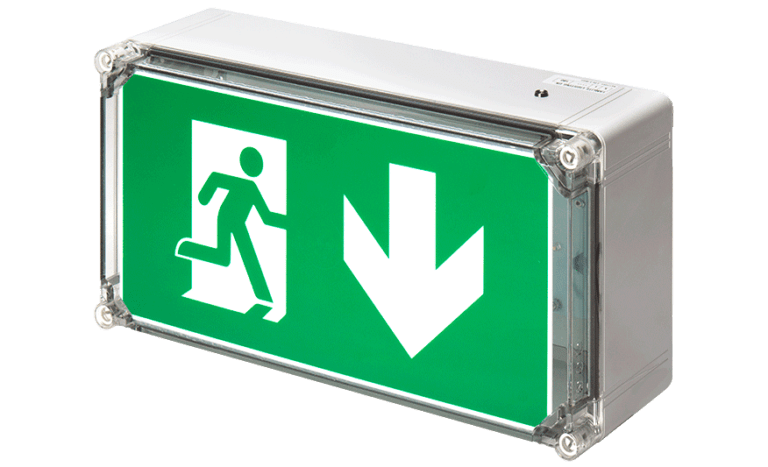
Emergency Lighting in a post-Hackitt Report world
Tamlite Lighting calls for the lighting industry to support contractors installing emergency lighting.
Following the Hackitt Report on Building Regulations and Fire Safety, set up in the wake of the Grenfell Tower tragedy, Colin Lawson, Head of Product Development, Sales & Marketing at Tamlite has called for urgent action.
The Hackitt review identified that “while there are many instances of competent people, there is no consistent way to assess or verify their competence. The current approach to levels of competence is disjointed and in places not rigorous enough. This allows individuals to practice with questionable qualifications or without a requirement for competence to be assessed, accredited and reaccredited.”
Colin Lawson, “The lighting industry should take the lead when it comes to working with our colleagues across the building sector to ensure building safety; our industry can’t just rest on its laurels regarding the training and ongoing professional development of its own specialists, but must work to improve that training across the entire construction industry.
“As buildings become ‘smarter’ with the integration of sophisticated controls systems for building functions from HVAC, to security, internet and energy, as well as lighting, it stands to reason that electrical contractors and their staff are kept fully trained on the necessary skills and knowledge to ensure smart buildings are safe buildings. There must be particular regard to the installation, ongoing testing and maintenance of safety/emergency lighting.

How the lighting industry can help contractors
“While there is no suggestion that the emergency lighting in Grenfell Tower was responsible for the loss of life, there have been indications that the lighting was unable to penetrate the unexpectedly intense smoke in the stairwell and so was prevented from fulfilling its purpose of guiding residents, visitors and firefighters around and out of the building safely.
“There are already a number of stringent qualifications that electrical contractors must have before they are allowed to work on construction sites, but there is no doubt that the lighting industry itself can play its part. Not only with CPD programmes, but also with clear and unequivocal advice on the regulations covering emergency lighting.
“With the right training and support, contractors will be able to reassure the building’s Facility Manager that the right products are installed in the right locations, and robust testing and maintenance programmes are in place. Put simply, an installation may require several types of emergency lighting product to fulfil the requirements of the building Standards and regulations; illuminating to different levels and light distribution dependent on the area.”
Match the product to the application
When specifying and installing emergency lighting, the contractor needs to take into account the following:
• Function of the building or room/area
• Mode of operation: residential, office, commercial, educational, care/healthcare
• Users’ familiarity with the building: predominantly residential/office/commercial or more frequently receiving short-term visitors, ie. Hospitality, museums etc
• Usage: will it change over time, such as from a warehouse with tall racking and aisles, to a retail space, or from an office that was originally open-plan, being converted to separate office spaces
• Aesthetics: modern buildings may have different aesthetic requirements to historic and listed buildings, whose lighting will need to be sensitive to their surroundings until required
In addition, consideration needs to be taken of the particular area of a building/room/corridor where the lighting is to be installed, with different fixture heights and distances being required for different applications:
• Final exit point
• Junction
• Corridors
• Stairways
• Emergency equipment areas
• Toilets
• Open areas
• Hazardous areas, or
• Control rooms]
As well as ensuring contractors have the information and qualifications to ensure they are installing to the relevant building standards, safety codes and legislation, responsible manufacturers can assist contractors and FMs with addressing their ongoing testing and maintenance responsibilities.

Safety – support and compliance
Post-installation monthly functionality testing and annual three-hour tests are stipulated by the aforementioned Standards. Often this takes the form of someone switching off the mains power, going to each individual emergency light to ensure the battery is supplying power and that this lasts for the minimum stipulated three hours. Naturally this relies on a strict adherence to a timetable of monitoring and testing, but leaves room for human error or disruption to the schedule.
However, bespoke solutions to ensure legal compliance in carrying out the testing process are available, including autonomous emergency lighting test solutions developed to be easy to access and update, with users able to download test logs and identify maintenance required. Such an autonomous system is invaluable in minimising the possibilities of human error, as well as ensuring compliance with safety legislation and insurance requirements. A robust overall monitoring and testing process supports strict audit procedures which ensure overall responsibility is correctly understood, and assigned to a ‘nominated’ individual.
Ultimately, “it is an offence for any ‘nominated’ person or business to fail to comply with any requirement or prohibition imposed under the fire safety articles, where that failure places one or more individuals at risk of death or serious injury in case of fire”. However, it is a defence for the person charged to prove that they took all reasonable precautions and exercised all due diligence to avoid the commission of such an offence.
Colin Lawson says, “It is the responsibility of lighting manufacturers and electrical contractors to ensure that the ‘nominated’ individual to whom they report for the work carried out, is fully appraised of the details and that it has met all the necessary legal requirements.
Conclusion:
As Colin Lawson says, “What Dame Judith Hackitt’s report has highlighted however, is that robust systems for ensuring a clear audit trail on maintenance and adaptations to buildings must be put in place; sooner rather than later. Responsibilities for ensuring the work meets fire and safety regulations and does not compromise the integrity of other, interdependent systems should be clear and unequivocal.
“Every sector of the construction industry needs to take responsibility for ensuring the highest safety standards are met on every project, whether new build or retrofit. We cannot wait for Government to legislate, or for new Building Regulations to be introduced. We must act now. We must lead the way in setting new standards, issuing guidance, developing training and, most of all, in ensuring competence and compliance – and this includes supporting our contractor colleagues with information and training.”
Colin Lawson says, “It is the responsibility of lighting manufacturers and electrical contractors to ensure that the ‘nominated’ individual to whom they report for the work carried out, is fully appraised of the details and that it has met all the necessary legal requirements.